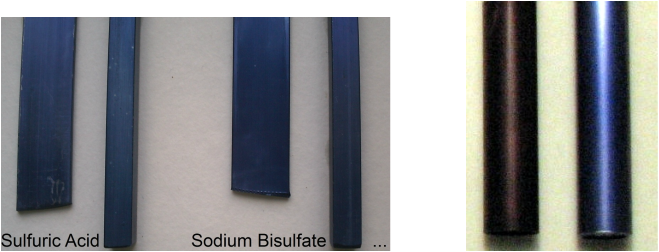[original post, restored by moderator]
I bought 5 litres of acid and cobbled this anodising bath together, easy as.
10litre plastic bucket filled with diluted acid, two aluminium cathodes, wired together, a Projecta battery charger/power supply and a bit of aluminium wire. I'll be updating the settup with titanium wire , lead cathodes and an ammeter as soon as they arrive. But it does a good job as it is.
First shot is the first piece I anodisied. This piece was mirror finished before being anodised. As you can see, it dulled the shine, but did give a nice finish. Second and third shots are of my second test piece, half the strip was polished, other half was brush finished, came out much the same both ends.
Final piece was the cable splitter I made. I assembled the the splitter with O rings on both end caps and inserted rubber bungs in the three holes before dunking it in the bath. This was necessary as the threads are a very neat fit, if anodised they wouldn't fit together. Also, I didn't want the bore anodised as this would effect the fit of the brass slide. Came out with a nice grey finish.
Happy with the results. Another tool to add to my collection.
I bought 5 litres of acid and cobbled this anodising bath together, easy as.
10litre plastic bucket filled with diluted acid, two aluminium cathodes, wired together, a Projecta battery charger/power supply and a bit of aluminium wire. I'll be updating the settup with titanium wire , lead cathodes and an ammeter as soon as they arrive. But it does a good job as it is.
First shot is the first piece I anodisied. This piece was mirror finished before being anodised. As you can see, it dulled the shine, but did give a nice finish. Second and third shots are of my second test piece, half the strip was polished, other half was brush finished, came out much the same both ends.
Final piece was the cable splitter I made. I assembled the the splitter with O rings on both end caps and inserted rubber bungs in the three holes before dunking it in the bath. This was necessary as the threads are a very neat fit, if anodised they wouldn't fit together. Also, I didn't want the bore anodised as this would effect the fit of the brass slide. Came out with a nice grey finish.
Happy with the results. Another tool to add to my collection.
Last edited by a moderator:



